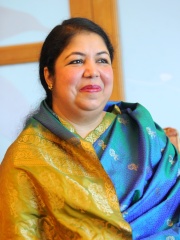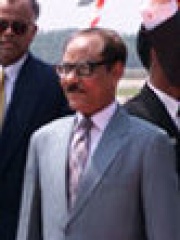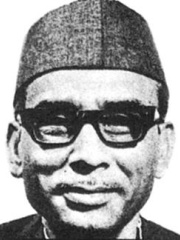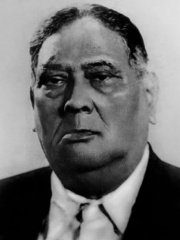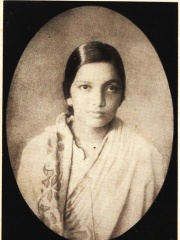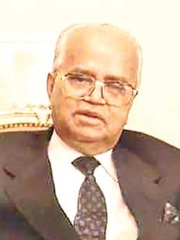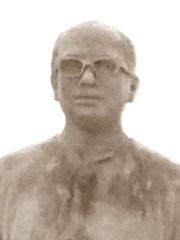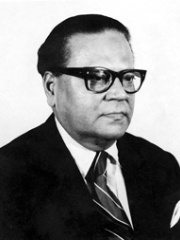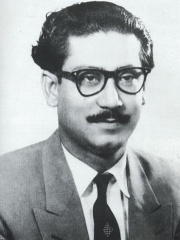
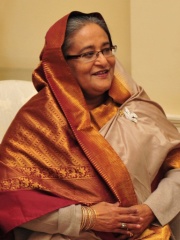
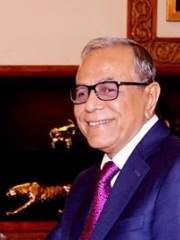
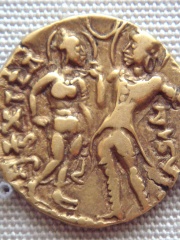
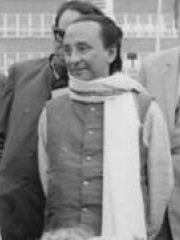
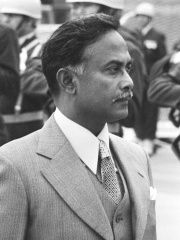
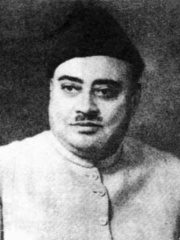
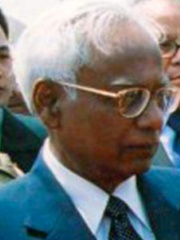
The Most Famous
POLITICIANS from Bangladesh
This page contains a list of the greatest Bangladeshi Politicians. The pantheon dataset contains 19,576 Politicians, 24 of which were born in Bangladesh. This makes Bangladesh the birth place of the 95th most number of Politicians behind Myanmar (Burma), and Slovenia.
Top 10
The following people are considered by Pantheon to be the top 10 most legendary Bangladeshi Politicians of all time. This list of famous Bangladeshi Politicians is sorted by HPI (Historical Popularity Index), a metric that aggregates information on a biography’s online popularity. Visit the rankings page to view the entire list of Bangladeshi Politicians.

1. Sheikh Mujibur Rahman (1920 - 1975)
With an HPI of 66.95, Sheikh Mujibur Rahman is the most famous Bangladeshi Politician. His biography has been translated into 80 different languages on wikipedia.
Sheikh Mujibur Rahman (17 March 1920 – 15 August 1975), popularly known by the honorific prefix Bangabandhu (lit. 'Friend of Bengal') was a Bangladeshi politician, revolutionary, statesman, activist and diarist. As a politician, Mujib had held continuous positions as president or prime minister from April 1971 until his assassination in August 1975: as president from 1971 to 1972 and briefly from 1975 until his death, and as prime minister from 1972 to 1975. Mujib successfully led the Bangladeshi independence movement and restored the Bengali sovereignty after over two centuries following the Battle of Plassey in 1757, for which he is honoured as the 'Father of the Nation' in Bangladesh. In 2011, the fifteenth constitutional amendment in Bangladesh referred to Sheikh Mujib as the Father of the Nation who declared independence; these references were enshrined in the fifth, sixth, and seventh schedules of the constitution. His Bengali nationalist ideology, socio-political theories, and political doctrines are sometimes called Mujibism. Mujib emerged as a student activist in the province of Bengal during the final years of the British Raj. He was a member of the All India Muslim League. In 1949, Mujib was part of a liberal, secular and leftwing faction which later became the Awami League. In the 1950s, Mujib was elected to Pakistan's parliament where he defended the rights of East Bengal; wore suits and bowties; and was described as urbane and charming. By the 1960s, Mujib was transformed into the nationalist leader of East Pakistan, with his trademark Mujib coat and forceful oratory. He became popular for opposing political, ethnic and institutional discrimination; leading the 6-point autonomy movement; and challenging the regime of Field Marshal Ayub Khan. In 1970, Mujib led the Awami League to win Pakistan's first general election. When the military junta refused to transfer power, he gave the 7th March speech and announced an independence movement. During the Bangladesh Liberation War in 1971, Mujib declared Bangladesh's independence. Bengali nationalists declared Mujib as the head of the provisional Bangladeshi government while he was confined in a jail in West Pakistan. He returned to Bangladesh in January 1972 as a hero. A populist of the 20th century, Sheikh Mujib was one of the most charismatic leaders of the Third World in the early 1970s. Mujib succeeded in normalizing diplomatic ties with most of the world, with a policy of friendship to all and malice to none. He signed a friendship treaty with India, joined the Commonwealth, NAM and the OIC, opposed apartheid and dispatched an army medical unit during the 1973 Arab-Israeli War. Mujib's legacies include the secularist Constitution of Bangladesh and the transformation of East Pakistan's state apparatus, bureaucracy, armed forces, and judiciary into an independent Bangladeshi state. He gave the first Bengali speech to the UN General Assembly in 1974. Mujib's five-year regime was also the only socialist period in Bangladesh's history. In 1975, Mujib installed a one party state which lasted for seven months until his assassination. Mujib's legacy remains divisive among Bangladeshis due to his economic mismanagement, the Bangladesh famine of 1974, human rights violations, and authoritarianism. The Awami League has been accused of promoting a personality cult around Mujib. But most Bangladeshis credit Mujib for leading the country to independence in 1971. In a 2004 BBC opinion poll, Mujib was voted as the Greatest Bengali of all time and ranked first on the list followed by Asia's first Nobel laureate Rabindranath Tagore (2nd) and Bangladeshi national poet Kazi Nazrul Islam (3rd). Mujib's 7 March speech in 1971 is recognized by UNESCO for its historic value, and enshrined in the Memory of the World Register – Asia and the Pacific. His diaries and travelogues were published many years after his death and have been translated into several languages.

2. Sheikh Hasina (b. 1947)
With an HPI of 63.56, Sheikh Hasina is the 2nd most famous Bangladeshi Politician. Her biography has been translated into 91 different languages.
Sheikh Hasina Wazed (Bengali: শেখ হাসিনা ওয়াজেদ; born 28 September 1947) is a Bangladeshi politician who has served as the tenth prime minister of Bangladesh from June 1996 to July 2001 and again since January 2009. She is the daughter of Sheikh Mujibur Rahman, the founding father and first president of Bangladesh. Having served for a combined total of over 19 years, she is the longest serving prime minister in the history of Bangladesh. As of 15 April 2024, she is the world's longest-serving female head of government.As the autocratic regime of Hussain Muhammad Ershad came to an end, Hasina, leader of the Awami League (AL), lost the 1991 election to Khaleda Zia, with whom she had collaborated against Ershad. As leader of the opposition, Hasina accused Zia's Bangladesh Nationalist Party (BNP) of electoral dishonesty and boycotted the parliament, which was followed by violent demonstrations and political turmoil. Zia resigned to a caretaker government, followed by Hasina becoming prime minister after the June 1996 election. While the country began to experience economic growth and a reduction in poverty, it remained in political tumult during her first term, which ended in July 2001 after an electoral defeat from Zia. This was the first full five-year term for a Bangladeshi prime minister since it became an independent country. During the 2006–2008 political crisis, Hasina was detained on extortion charges. After her release from jail, she won the 2008 election. In 2014, she was re-elected for a third term in an election that was boycotted by the BNP and criticised by international observers. In 2017, after nearly a million Rohingya entered the country, fleeing genocide in Myanmar, Hasina received credit and praise for giving them refuge and assistance. She won her fourth term after the 2018 election, which was marred with violence and widely criticised as being rigged. Under her tenure as prime minister, Bangladesh has experienced democratic backsliding. Human Rights Watch documented widespread enforced disappearances and extrajudicial killings under her government. Many politicians and journalists have been systematically and judicially punished for challenging her views. In 2021, Reporters Without Borders gave a negative assessment of Hasina's media policy for curbing press freedom in Bangladesh since 2014. Hasina was among Time's 100 most influential people in the world in 2018, and among the 100 most powerful woman in the world by Forbes magazine in 2015, 2018, and 2022.

3. Abdul Hamid (b. 1944)
With an HPI of 62.94, Abdul Hamid is the 3rd most famous Bangladeshi Politician. His biography has been translated into 63 different languages.
Mohammad Abdul Hamid (born 1 January 1944) is a Bangladeshi politician who served as the president of Bangladesh from 2013 to 2023. He was elected to his first term in April 2013, and re-elected in 2018. Previously, he served as the speaker of the Jatiya Sangsad from January 2009 to April 2013. He was the acting president after the death of Zillur Rahman in March 2013. He was the longest serving president in the history of Bangladesh.

4. Chandragupta I (250 - 335)
With an HPI of 58.10, Chandragupta I is the 4th most famous Bangladeshi Politician. His biography has been translated into 41 different languages.
Chandragupta I (Gupta script: Cha-ndra-gu-pta, r. c. 319–335/350 CE) was a king of the Gupta Empire, who ruled in northern and central India. His title Mahārājadhirāja ("Great king of kings") suggests that he was the first emperor of the dynasty. It is not certain how he turned his small ancestral kingdom into an empire, although a widely accepted theory among modern historians is that his marriage to the Licchavi princess Kumaradevi helped him extend his political power. Their son Samudragupta further expanded the Gupta empire.
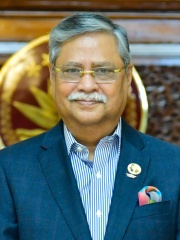
5. Mohammed Shahabuddin (b. 1949)
With an HPI of 56.91, Mohammed Shahabuddin is the 5th most famous Bangladeshi Politician. His biography has been translated into 28 different languages.
Mohammed Shahabuddin (born 10 December 1949) is a Bangladeshi jurist, civil servant, and politician who is the 16th and incumbent President of Bangladesh. He was elected unopposed in the 2023 presidential election in the nomination of the ruling Awami League. Prior to his presidency, he served as a district and sessions judge and a commissioner of the Anti-Corruption Commission from 2011 to 2016.

6. Zillur Rahman (1929 - 2013)
With an HPI of 56.38, Zillur Rahman is the 6th most famous Bangladeshi Politician. His biography has been translated into 50 different languages.
Mohammed Zillur Rahman (9 March 1929 – 20 March 2013) was a Bangladeshi politician who served as the President from 2009 to his death in 2013. He was also a senior presidium member of the Awami League. He is the third president of Bangladesh, after Sheikh Mujibur Rahman and Ziaur Rahman, to die in office, while being the first to die of natural causes.

7. Ziaur Rahman (1936 - 1981)
With an HPI of 55.63, Ziaur Rahman is the 7th most famous Bangladeshi Politician. His biography has been translated into 40 different languages.
Ziaur Rahman (19 January 1936 – 30 May 1981) was a Bangladeshi military officer and politician who served as the President of Bangladesh from 1977 until his assassination. He was the founder of the Bangladesh Nationalist Party (BNP) and served as its chairman until his assassination. He previously served as the second chief of army staff from 1975 to 1978 with a minor break. Ziaur, sometimes known as Zia, was born in Gabtali and trained at the Pakistan Military Academy in Abbottabad. He served as a commander of the Pakistan Army in the Second Kashmir War against the Indian Army, for which he was awarded the Hilal-e-Jurrat from the Pakistani government. Ziaur was a prominent Bangladesh Forces commander during the country's Independence war from Pakistan in 1971. He originally broadcast the Bangladesh declaration of independence on 27 March from Kalurghat radio station in Chittagong. After the war of Independence, Ziaur became a brigade commander in Bangladesh Army, and later the deputy chief of staff and chief of staff of Bangladesh Army. His ascent to leadership of the country resulted from a conspiracy that had begun with the killing of Sheikh Mujibur Rahman, the founding president of Bangladesh, in a military coup d'état followed by a coup and counter-revolt within the military to gain control at the helm. Ziaur Rahman gained de facto power as head of the government already under martial law imposed by the Mushtaq government. He took over the presidency in 1977. As president in 1978, Ziaur Rahman founded the Bangladesh Nationalist Party (popularly known by its abbreviation BNP). He reinstated multi-party politics, freedom of the press, free speech and free markets and accountability. He initiated mass irrigation and food production programmes, including social programmes to uplift the lives of the people. His government initiated efforts to create a regional group in South Asia, which later became SAARC in 1985. He improved Bangladesh's relations with the West and China, and departed from Sheikh Mujibur Rahman's close alignment with India. Domestically, Ziaur Rahman faced as many as twenty-one coup attempts for which military tribunals were set up, resulting in thousands of Army and Air Force officers being executed, earning him a reputation of being 'strict' and 'ruthless' amongst international observers. Throughout his military career, Ziaur Rahman was awarded two gallantry awards for two campaigns he participated in; he was awarded the Hilal-i-Jurat for the Indo-Pak War in 1965, and Bir Uttom in 1972 for the Bangladesh Liberation War. He retired from the Bangladesh Army with the rank of Lt. General in 1978.Ziaur Rahman's death created a divided opinion on his legacy in Bangladeshi politics. Awami League supporters vilify him for alleged connections to Mujib's assassination and controversial actions during his presidency. Critics argue that the current authoritarian regime politically motivated the negative portrayal of Ziaur's legacy. Nevertheless, Rahman is generally credited for his role in the Liberation War, stabilizing Bangladesh, industrializing agriculture, and fostering regional cooperation. His political party, the BNP, remains a major force alongside its rival, the Awami League, with his wife, Khaleda Zia, leading the party and serving two terms as prime minister.

8. Khawaja Nazimuddin (1894 - 1964)
With an HPI of 54.42, Khawaja Nazimuddin is the 8th most famous Bangladeshi Politician. His biography has been translated into 36 different languages.
Sir Khawaja Nazimuddin (19 July 1894 – 22 October 1964) was a Pakistani politician and statesman who served as the second governor-general of Pakistan from 1948 to 1951, and later as the second prime minister of Pakistan from 1951 to 1953. Born into an aristocratic Nawab family in Bengal in 1894, he was educated at the Aligarh Muslim University before pursuing his post-graduation studies at the Cambridge University. Upon returning, he embarked on his journey as a politician on the platform of All-India Muslim League. Initially, his political career revolved around advocating for educational reforms and development in Bengal. Later on he started supporting the cause for a separate Muslim homeland, rising to become the party's principal Bengali leader and a close associate of Muhammad Ali Jinnah. He served as Prime Minister of Bengal in British India from 1943 to 1945, and later as the 1st Chief Minister of East Bengal in independent Pakistan. Nazimuddin ascended to Governor-General in 1948 after the death of Jinnah, before becoming Prime Minister in 1951 following the assassination of his predecessor, Liaquat Ali Khan. His term was marked by constant power struggles with his own successor as Governor-General, Ghulam Muhammad, as law and order deteriorated amid the rise of the Bengali language movement and protests in his native Dhaka in 1952, and religious riots in Lahore a year later. The latter crisis saw the first instance of martial law, limited to the city, and led to Governor-General Ghulam Muhammad dismissing Nazimuddin on 17 April 1953. Nazimuddin's ministry was the first federal government to be dismissed in Pakistan's history, though his former ministers Sardar Abdur Rab Nishtar, Abdul Sattar Pirzada, and Mahmud Husain refused to take the oath of office in the new cabinet. He retired from national politics, passing away after a brief illness in 1964. He is buried at the Mausoleum of Three Leaders in Dhaka. He was one of the leading founding fathers of Pakistan and the first Bengali to have governed Pakistan.

9. Iajuddin Ahmed (1931 - 2012)
With an HPI of 54.26, Iajuddin Ahmed is the 9th most famous Bangladeshi Politician. His biography has been translated into 44 different languages.
Iajuddin Ahmed (1 February 1931 – 10 December 2012) was the President of Bangladesh, serving from 6 September 2002 until 12 February 2009. From late October 2006 to January 2007, he also served as Chief Advisor of the caretaker government. From October 2006 to early 2008, his responsibilities as president included the Defense Ministry of the caretaker government. With a doctorate in soil science, Ahmed became a full professor at the University of Dhaka and chairman of the department. Beginning in 1991, he started accepting appointments to public positions, as chairman of the Public Service Commission (1991 to 1993) and of the University Grants Commission (1995 to 1999). In 2002 he won election as president. In 2004 he helped establish the private university, Atish Dipankar University of Science and Technology (ADUST).
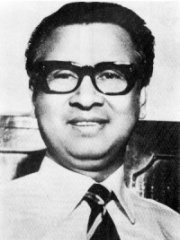
10. Tajuddin Ahmad (1925 - 1975)
With an HPI of 53.40, Tajuddin Ahmad is the 10th most famous Bangladeshi Politician. His biography has been translated into 24 different languages.
Tajuddin Ahmad (Bengali: তাজউদ্দীন আহমদ; Bengali pronunciation: [ˈtaːdʒudːin ˈaɦmɔd]; 23 July 1925 – 3 November 1975) was a Bangladeshi politician and statesman. He led the Provisional Government of Bangladesh as its prime minister during the Bangladesh Liberation War in 1971 and is regarded as one of the most instrumental figures in the birth of Bangladesh. Tajuddin began as a Muslim League youth worker in British India. He belonged to the Dhaka-based pro-democracy, secular Muslim League faction, which broke with the Muslim League's reactionary party line after the partition of India and the birth of Pakistan. As a member of the short-lived youth organisation the Jubo League, he actively participated in the Language Movement in 1952. In 1953, he joined the Awami Muslim League (later the Awami League), a dissident offshoot of the Muslim League. The following year, he was elected a member of the East Pakistan Provincial Assembly. As a close confidante, he assisted Sheikh Mujibur Rahman in revitalising the Awami League into a secular political party during Ayub Khan's regime in the late 1960s. As the General Secretary of the Awami League from 1966, Tajuddin coordinated the party during the tumultuous late 1960s and early 1970s, suffering imprisonment on several occasions. He formulated the early draft of the historic six-points demand that would eventually lead to the birth of Bangladesh. He coordinated the Awami League's election campaign for the 1970 Pakistani general election, in which the League gained a historic parliamentary majority. He also coordinated the non-cooperation movement of March 1971 precipitated by President Yahya Khan's delay in transferring power to the elected legislators. Tajuddin was among Sheikh Mujib's delegation in the Mujib-Yahya talks to settle the constitutional disputes between East and West Pakistan and transfer power to the elected National Assembly. Following the Pakistani army's crackdown on the Bangladeshi population on 25 March 1971, Tajudddin escaped to India. In the absence of Sheikh Mujib, he initiated the set up of the Provisional Government of Bangladesh in 1971 and headed it, operating in exile in India, as its prime minister. In independent Bangladesh, Tajuddin served as the Minister of Finance and Planning in Sheikh Mujib's Cabinet from 1972 to 1974. He was also a member of the committee drafting the Constitution of Bangladesh. He resigned from the cabinet in 1974 to live a quiet life. Following Sheikh Mujib's assassination in a coup d'état, Tajuddin was arrested and assassinated on 3 November 1975, along with three senior Awami League leaders in prison.
People
Pantheon has 26 people classified as Bangladeshi politicians born between 250 and 1983. Of these 26, 5 (19.23%) of them are still alive today. The most famous living Bangladeshi politicians include Sheikh Hasina, Abdul Hamid, and Mohammed Shahabuddin. The most famous deceased Bangladeshi politicians include Sheikh Mujibur Rahman, Chandragupta I, and Zillur Rahman. As of April 2024, 3 new Bangladeshi politicians have been added to Pantheon including Mohammed Shahabuddin, Syed Nazrul Islam, and A. F. M. Ahsanuddin Chowdhury.
Living Bangladeshi Politicians
Go to all RankingsSheikh Hasina
1947 - Present
HPI: 63.56
Abdul Hamid
1944 - Present
HPI: 62.94
Mohammed Shahabuddin
1949 - Present
HPI: 56.91
Shirin Sharmin Chaudhury
1966 - Present
HPI: 40.29
Mashrafe Mortaza
1983 - Present
HPI: 30.02
Deceased Bangladeshi Politicians
Go to all RankingsSheikh Mujibur Rahman
1920 - 1975
HPI: 66.95
Chandragupta I
250 - 335
HPI: 58.10
Zillur Rahman
1929 - 2013
HPI: 56.38
Ziaur Rahman
1936 - 1981
HPI: 55.63
Khawaja Nazimuddin
1894 - 1964
HPI: 54.42
Iajuddin Ahmed
1931 - 2012
HPI: 54.26
Tajuddin Ahmad
1925 - 1975
HPI: 53.40
Shahabuddin Ahmed
1930 - 2022
HPI: 52.92
Khondaker Mostaq Ahmad
1918 - 1996
HPI: 51.52
A. K. Fazlul Huq
1873 - 1962
HPI: 50.93
Kalpana Datta
1913 - 1995
HPI: 50.49
Abdur Rahman Biswas
1926 - 2017
HPI: 48.97
Newly Added Bangladeshi Politicians (2024)
Go to all RankingsMohammed Shahabuddin
1949 - Present
HPI: 56.91
Syed Nazrul Islam
1925 - 1975
HPI: 48.48
A. F. M. Ahsanuddin Chowdhury
1915 - 2001
HPI: 45.89
Overlapping Lives
Which Politicians were alive at the same time? This visualization shows the lifespans of the 20 most globally memorable Politicians since 1700.

